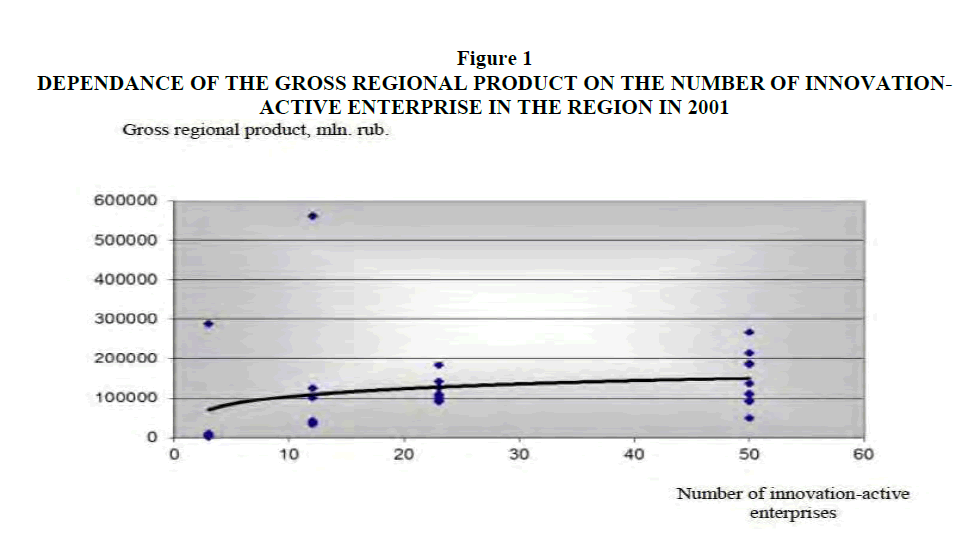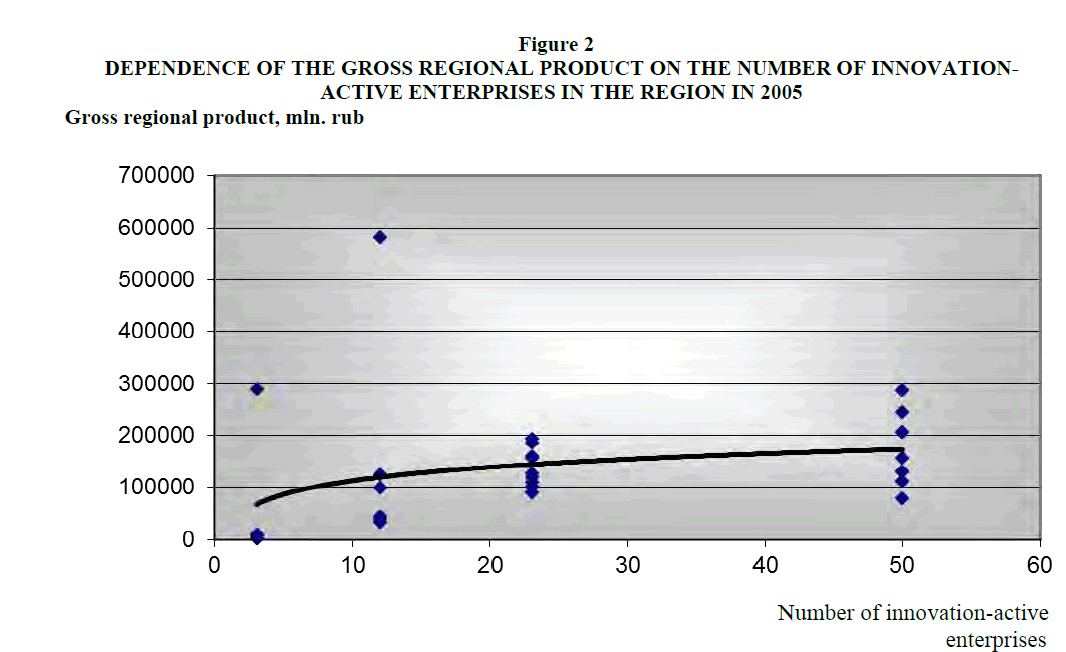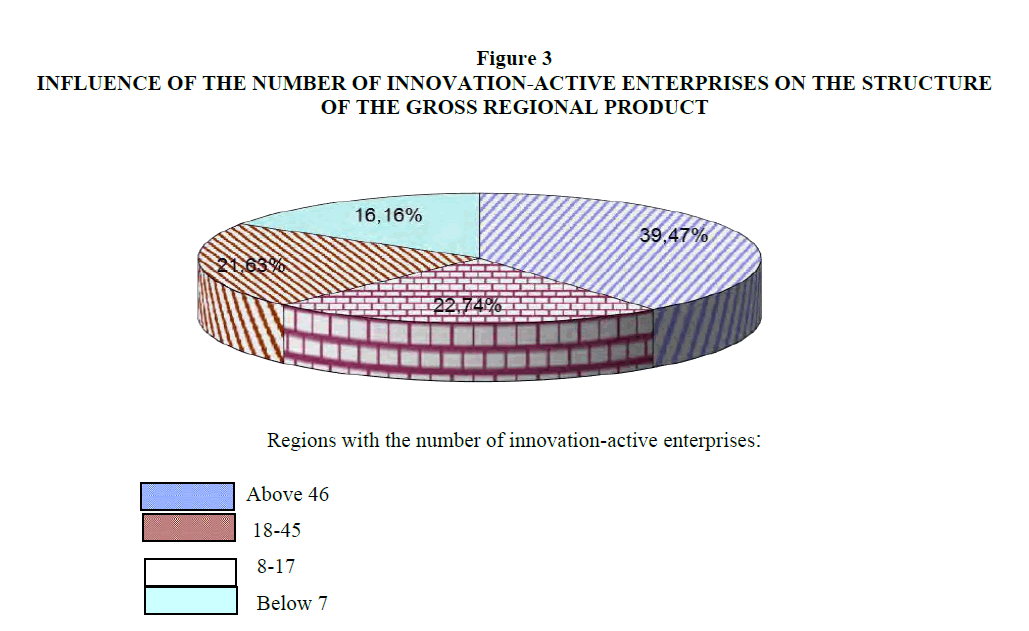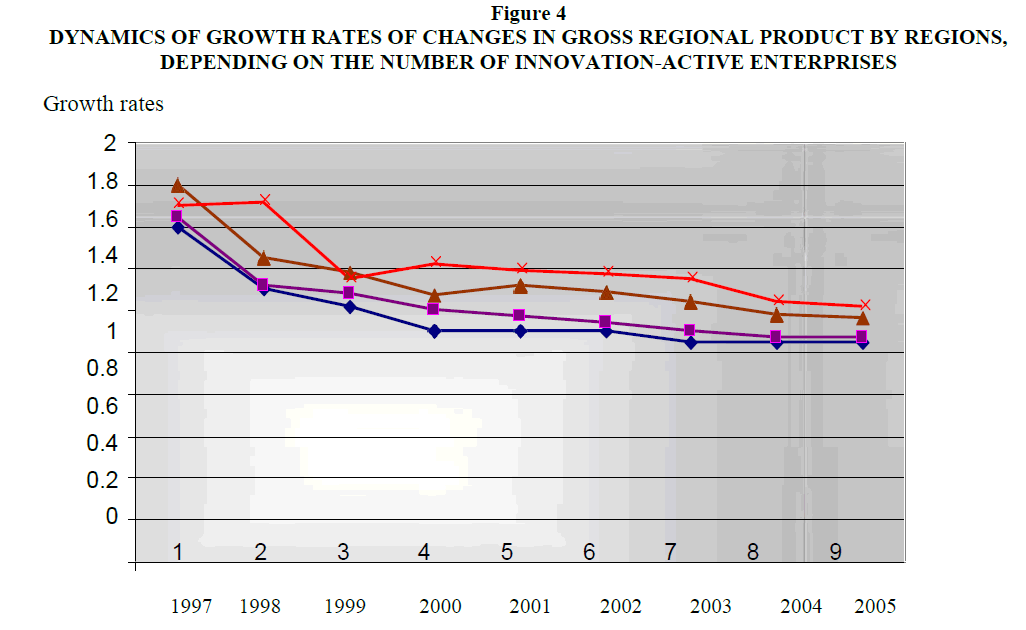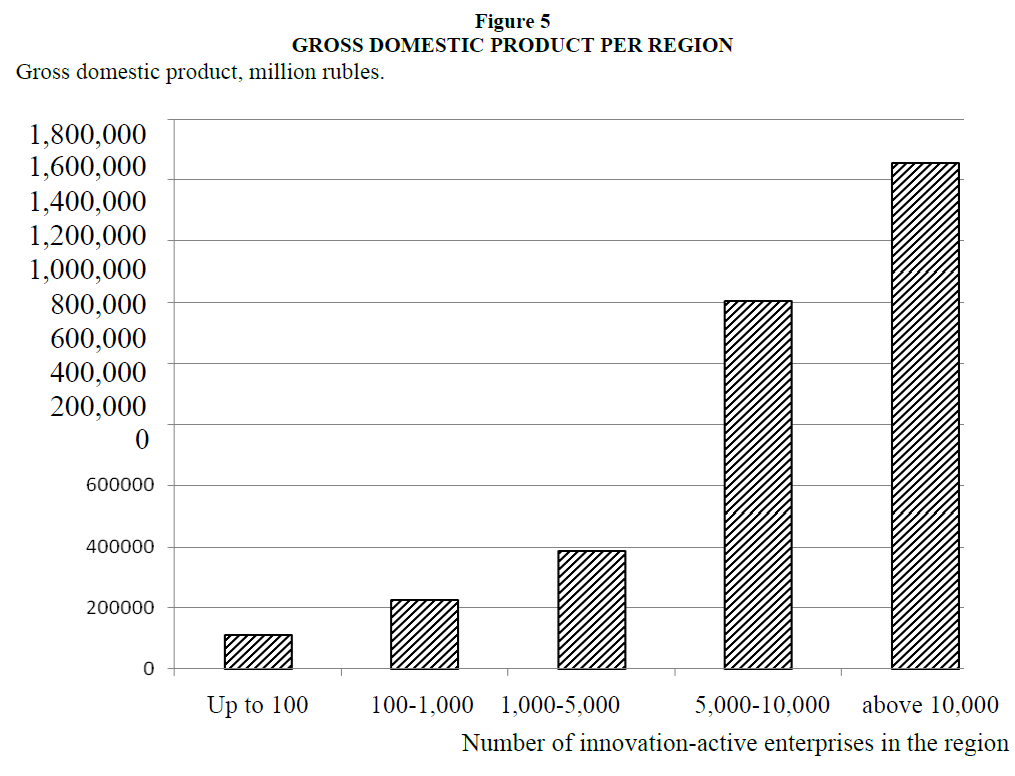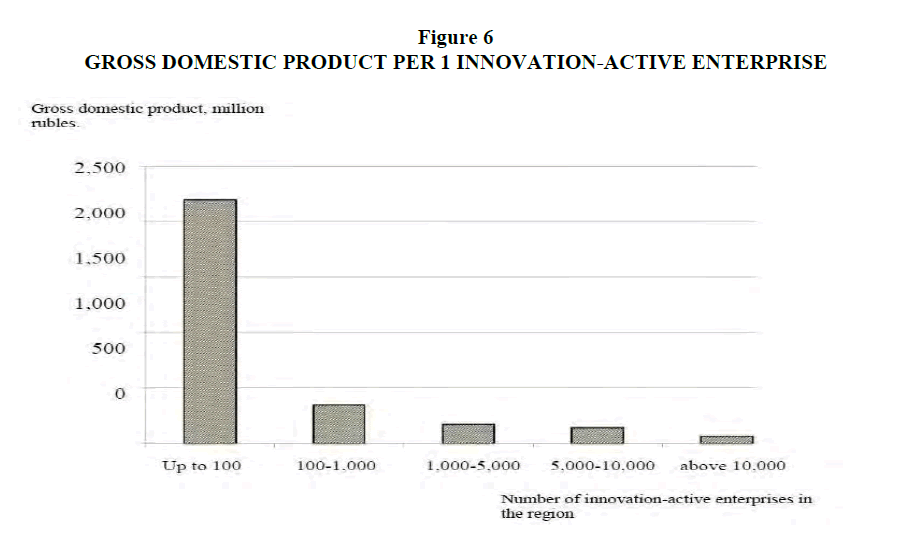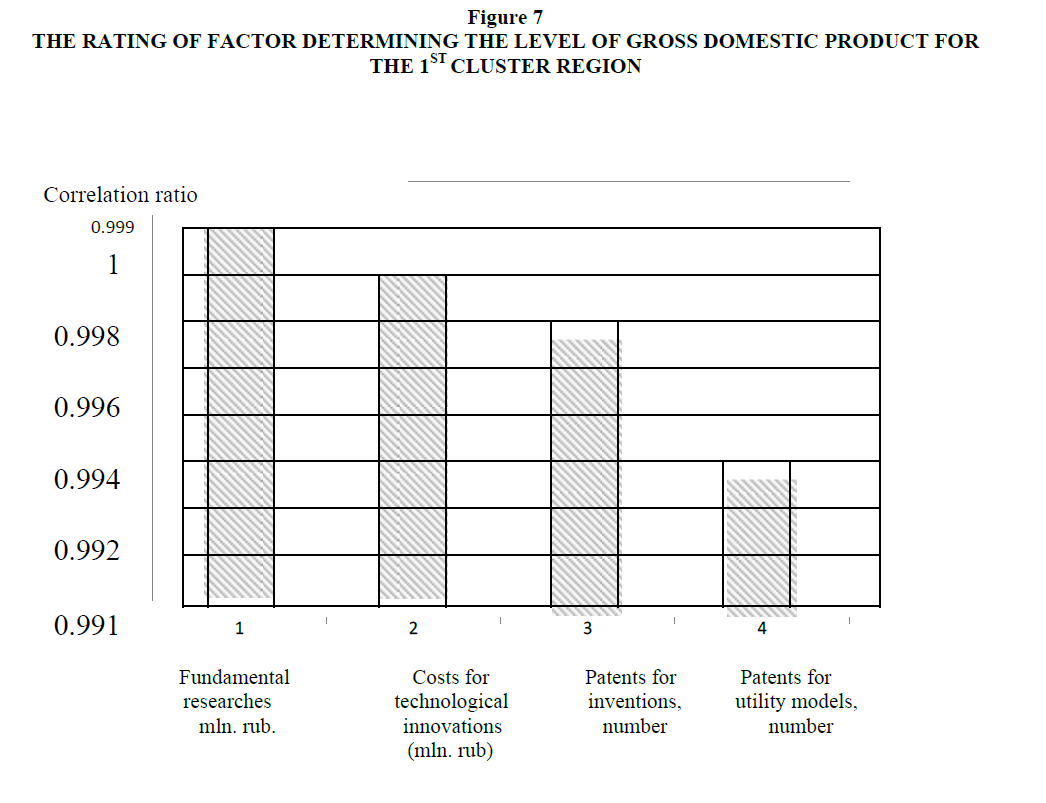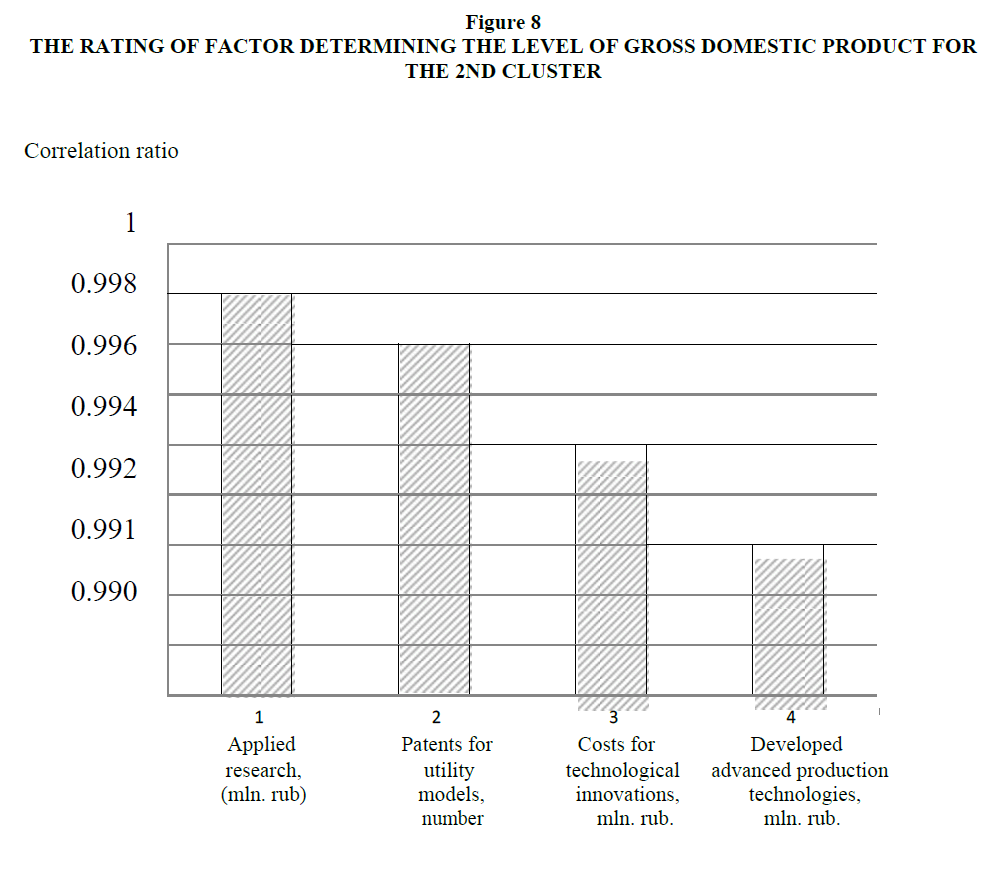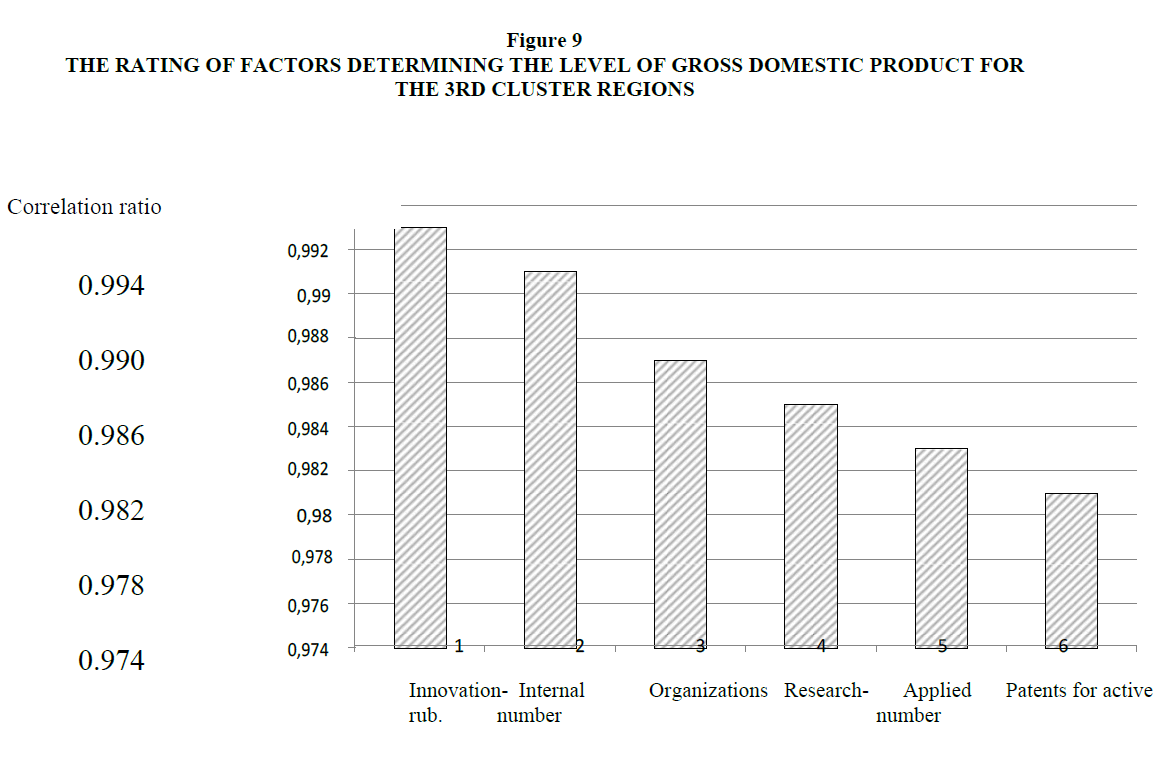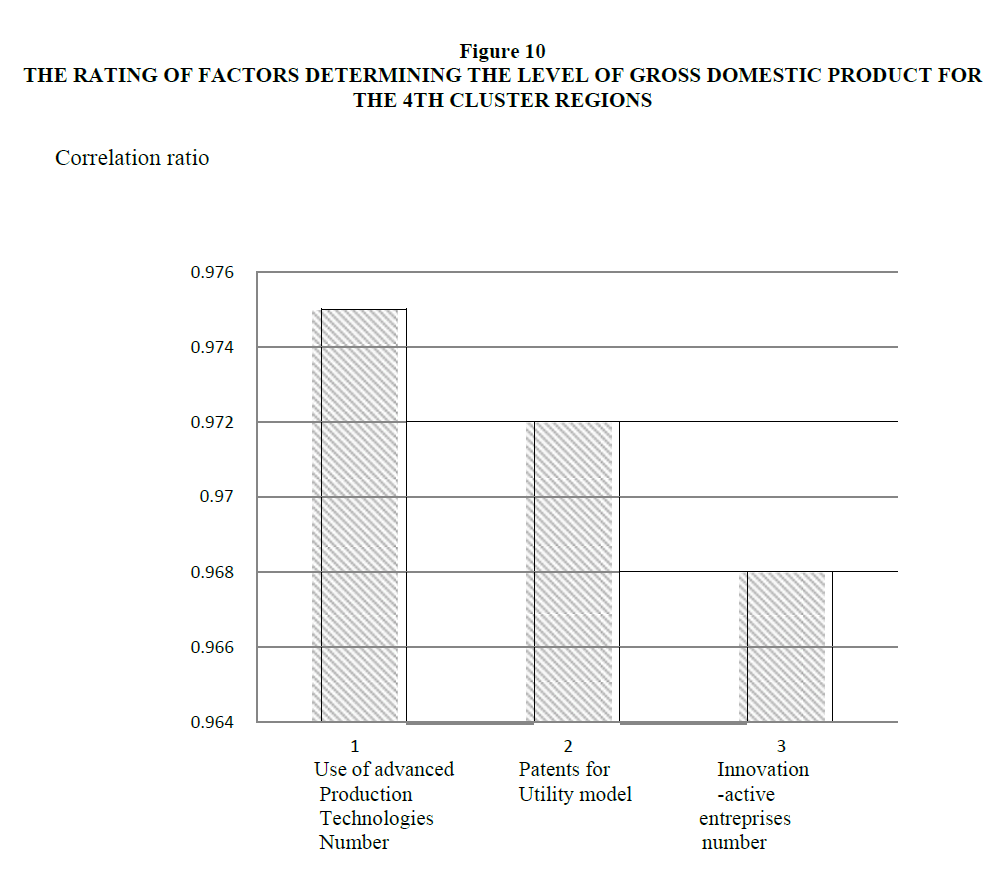Original Articles: 2017 Vol: 16 Issue: 1
Regional Features of the Innovative Activity Formation as a Determining Factor in the Development of the Russian Economy
Elena Petrovna Kiselitsa, Tyumen State University
Natalia Nikolaevna Shilova, Industrial University of Tyumen
Irina Aleksandrovna Liman, Tyumen State University
Keywords
innovative activity, regional features, innovation-active enterprises.
Introduction
In the modern economy, the innovative activity plays a leading role, which is the logical end to the stage of the industrial economy and the transition to its postindustrial phase. This process is uneven in the time and space of economic activities of individual countries and even the regions of the country, and the process of shaping the trajectory to the innovative future is determined by personnel, scientific and technical, production, technological, financial, organizational, and other features of individual territories (Gabor Bekes Clusters, 2008). One of such components is the innovative activity of the territory, which determines the possibilities of implementing its innovative potential and characterizing, in its turn, the degree of the innovation activity effectiveness.
Innovative activity is widely regarded as the main factor of the economic growth of the territory (Porter M. E., 2003, Bilbao-Osorio B., & Rodriguez-Pose A., 2004). However, the results of empirical studies evaluating the effectiveness of individual measures to stimulate the innovation activity proposed in theoretical works are often contradictory. The "arbitrary" choice of factors included in the empirical model of the study may be one of the reasons to that effect (Mariyev O. S., & Reshetova Ya. M. & Savin IV., 2006). The papers consider various factors that stimulate the innovative activity of the regions, including a wide range from the level of competition in the market to the economies of scale or diffusion of technologies (Adam B. Jaffe, & Josh Lerner, & Scott Stem., 2005). Most authors pay attention to such variables as internal costs for research and development, investment in fixed assets, the volume of innovative goods, works and services, and the costs of technological innovation (Lundvall, B. & Ernst, D., 1997, Dodgson M., 2000).
However, some authors insist on the existence of an inverse relationship, in which the level of development of the regional economy, the level of income of residents, social differentiation, and the development cost component in research and development costs determine its innovative activity (Grasmik K.I., 2010).
The debate on what leads to regional economic growth and a significant increase in the gross regional product is not over yet: specialization or differentiation of sectors, or an innovative component in the context of interrelated economic platforms (Hasan I., & Wachtel P. (Hasan I., & Wachtel P. & Zhou M., 2009, Percev S.B., 2013).
The contribution of small business to the development of territories was also broadly investigated (Arora A. and Gambardella A., 2011). The backwardness of small business in innovative development from medium and large business is noted: generally, 10.1% of enterprises implement technological innovations on the economy as a whole, and small enterprises - only 5.1% (The data, http://www.gks.ru/). The gap in terms of the share of innovative goods in the total production was as follows: 6.3% in the economy as a whole, and only 1.48% - on small enterprises (The data, http://www.gks.ru/).
In this regard, it can be stated that the integral index of innovation activity in the regions corresponds to a certain extent to the value of the gross regional product, but the relationship between these indicators has not been sufficiently studied.
Different clustering options were performed and types of regions with different innovative potential were allocated in the literature (Solvell O., & Lindqvist G., & Ketels Ch., 2003, Volkova N. N., & Romanyuk E.I., 2012, Shilova N. N., & Kiselitsa E.P., & S. A. Lyuft S.A., 2016).). However, the dependence between the factors determining the degree of innovative development in each particular case is poorly studied.
All this complicates the adequate assessment of the parameters of economic impact on regional entities and stimulation of innovative factors for their development and increase in gross regional product and predetermines the further feasibility of research in this area.
Methods
The works of foreign and national researchers in the field of economics, including modern achievements in the field of information and institutional economics, have served as a methodological basis of the study. Methodologically, this research is based on the methods of logical, system and structural analysis, decision theory, general systems theory, expert assessments, system analysis, sociological researches, economic and mathematical modeling expert assessments, and others.
Foreign and domestic monographic proceedings, regulatory acts of the Government of the Russian Federation, reference materials of the Federal Service of State Statistics of Russia, materials of conferences and seminars, data from periodicals, Internet sources, and the empirical data obtained by the authors as a result of independent research have served as the informationempirical basis of the study.
Thus, the analysis of innovation activities is performed based on the results of statistical studies of various levels: nationwide, regional and corporate. Due to this, the authors note the following difficulties caused by the need to compare all the data under study: the irregular nature of the research conducted and their selective nature, the large array of data under study, the selection of various features that do not coincide year by year.
However, the adopted research methodology allowed the authors to obtain reliable results and ensure the adequacy of the representation of the subject of research, which was confirmed by the results of the practical implementation of made theoretical conclusions.
The practical significance of this study is that the results obtained by the authors can be used to study the determining trends in the economy of the territories, to predict their further development, and to reveal the features of the influence of key factors on the gross regional product. Also, taking into account sound theoretical positions, it seems expedient to determine the role of specific innovation factors in the development of individual territories.
Results
It is beyond argument that the results of scientific and technical progress in the implementation of the innovative potential of the territory play a decisive role. Scientific achievements and their active use in practical activities allowed the economically developed countries to ensure a leading innovation position. The studies carried out by the authors in 2005 on 71 out of 89 constituent territories of the Russian Federation made it possible to establish that the size of the gross regional product in Russia was largely determined by the number of innovation-active enterprises in the region (Figure 1, Figure 2) (The data, http://www.gks.ru/).
Figure 1.Dependance Of The Gross Regional Product On The Number Of Innovation Active Enterprise In The Region In 2001
Figure 2.Dependence Of The Gross Regional Product On The Number Of Innovation Active Enterprises In The Region In 2005.
The growth in the number of innovation-active enterprises ensured the growth of the gross regional product more than 2 times. About 39.5% of the gross regional product in Russia is provided by regions with over 46 innovation-active enterprises and regions with the smallest number of innovation-active enterprises (less than 7) - total 16.16% (Fig. 3). Despite a large number of "backward" regions, their contribution to the total gross regional product is much lower than that of innovation-active ones, and the growth rate of the gross regional product is 1.5 times lower (Figure 3, Figure 4).
Figure 3.Dependence Of The Gross Regional Product On The Number Of Innovation Active Enterprises In The Region In 2005.
Figure 4.Dynamics Of Growth Rates Of Changes In Gross Regional Product By Regions, Depending On The Number Of Innovation-Active Enterprises
Number of innovation-active enterprises - below 7
Number of innovation-active enterprises - 8-17
Number of innovation-active enterprises - 18-45
Number of innovation-active enterprises - above 46
The studies carried out by the authors in 2015 on 80 out of 85 constituent territories of the Russian Federation confirmed the findings, in particular, the revealed dependence of the magnitude of the gross regional product on the number of innovation-active enterprises in the region (The data, http://www.gks.ru).
About 41.3 % of the gross regional product in Russia is provided by regions with over 46 innovation-active enterprises and regions with the smallest number of innovation-active enterprises (less than 7) - total 14.4%. The growth in the number of innovation-active enterprises ensured the growth of the gross regional product in 2005 - more than 2 times. Despite the remaining large number of "backward" regions, their contribution to the total gross regional product is much lower than that of innovation-active ones, and the growth rate of the gross regional product is 1.5 times lower.
The close dependence (correlation ratio 0,947) of the gross domestic product in the region was revealed depending on the number of innovation-active enterprises therein (Figure 5).
The level of gross domestic product in regions with a greater number of innovation-active enterprises is significantly higher (the R2 was 0.978). In regions with the number of innovationactive enterprises less than 100, the gross domestic product averages 110,557.3 million rubles, and in regions with the number of innovation-active enterprises of more than 10,000 - 1,654,444 million rubles. Thus, the growth of the gross domestic product positively and steadily correlates with the expansion of the territorial space of innovation-active enterprises. Moreover, the likelihood of an increase in the gross domestic product under the influence of an increase in the share of innovation-active enterprises is significantly higher than under the influence of the share of the costs of research and development.The growth rates of gross domestic product with an increase in the number of innovation-active enterprises in the region are of particular interest. In regions where their number is from 100 to 1,000, gross domestic product is 1.7 times more than in regions with the number of innovation-active enterprises below 100. The transition to the next group (the number of innovation-active enterprises from 1,000 to 5,000) assumes an increase in gross domestic product 2.05 times, further (5,000-10,000) - 3.1 times. The subsequent transition of the region into a group with a number of innovative active enterprises of more than 10,000 is accompanied by a decrease in growth rates; the gross domestic product increases only 1.37 times. However, the slowdown in growth does not mean that it is not advisable to stimulate the creation of new innovation-active enterprises in such regions, despite the fact that the share of innovation-active enterprises therein is several times higher than that in regions with a low number of innovation-active enterprises. For example, in regions with the number of innovationactive enterprises of up to 100, the share of innovation-active enterprises is only 2.1%, and in regions with more than 10,000 - 18.9%. The increase in the number of innovation-active enterprises 9 times implies an increase in gross domestic product 14.9 times.
A high number of innovation-active enterprises in some regions are achieved, first of all, due to the active development of small innovative enterprises (Figure 6).
In regions with a small number of innovation-active enterprises (up to 100), one innovation-active enterprise contributes about 2,196 million rubles to the gross domestic product of the region's enterprise, and in regions with a large number (over 10,000) - only about 62 million rub. Such a gap of 35.4 times is very meaningful: on the one hand, it characterizes the objective processes occurring in the regions, and, on the other hand, it shows that the measures aimed at activating small businesses are timely and relevant.
The increase in the number of innovation-active enterprises by the regions with a low number (up to 1,000) per 1% makes it possible to increase the gross domestic product by 0.15%. A similar indicator for regions with the number of enterprises from 1,000 to 5,000 was 0.39%, from 5,000 to 10,000 - 1.23%. In regions with a large number of innovation-active enterprises (more than 10,000), the growth of gross domestic product decreased to 0.36%. Thus, the greatest effect allows obtaining a transfer of the region from the group of low-cost innovation-active enterprises to the group with their number from 5,000 to 10,000.
The bare fact that the innovation activity of the economies of a particular region reflects the nature of the dynamics of quantitative changes in the innovation components in the gross domestic product is undeniable. The authors made an attempt to study the influence of various factors characterizing the innovative activity of enterprises on the change in the gross domestic product, which included:
? internal costs of research, million rubles;
? costs for basic research, million rubles;
? patents for inventions, number;
? costs for technological innovation, million rubles;
? patents for utility models, number;
? a number of personnel involved in research, persons;
? a number of organizations performing research and development, units;
? a number of researchers, persons;
? costs for current developments, million rubles;
? costs for applied research, million rubles;
? used advanced production technology, number;
? developed advanced production technologies, number; and
? A number of innovation-active enterprises, total, units.
The given list of indicators is a quite extensive one and covers not only various aspects of innovation activity, but also those adjacent to it. For objective monitoring, it is necessary to conduct research on a wider range of indicators and on a regular basis, but unfortunately, such an extent of such research is extremely rare. Therefore, it was necessary to use mostly the data of the Federal State Statistics Service.According to the authors; innovation activity is primarily determined by the results of the activity of the factors determining it. However, some of the most important indicators, such as the Russian-specific investments in science and innovation, somewhat distort the magnitude of the innovative effect achieved (correlation ratio for Russia was 0.27 and for the United States - 0.83 (The data, http://www.gks.ru/)). This is partly due to the uneven nature of the innovation process in Russia by regions. Therefore, this research was carried out for 4 groups of regions - clusters, differing in the level of innovative development due to different historically developed levels, geographic and economic factors (Volkova N. N., & Romanyuk E.I., 2012). At the first stage, the authors formed a matrix for all selected indicators and all regions by three time periods: 2005, 2010 and 2015. The filling of the data matrix is close to 100%, but some missing values had to be introduced artificially. For some indicators, for which there is no data in individual regions, for example, the number of patents and inventions or the number of advanced technologies used, the missing indicators have been replaced by the minimum values for this indicator.
To study the impact of innovation activity in specific regions on the volume and dynamics of gross domestic product, the correlation ratios between gross domestic product and integral indices on the data matrix in 2005, 2010 and 2015 were calculated. The heterogeneity of innovative processes in each cluster predetermines the ambiguity of the influence of various factors on the change in the gross domestic product.
Thus, the first cluster includes 17 regions of the predominantly European part of the Russian Federation: Moscow, Vladimir, Kaluga, Ryazan and other regions. They have sufficiently developed significant innovative potential, as well as opportunities for activating its use. Therefore, the volume of fundamental research, the costs of technological innovation and the number of patents for inventions and utility models are of paramount importance for this cluster (Figure 7).
Figure 7.The Rating of Factor Determining the Level of Gross Domestic Product for the 1st Cluster Region
The regions of this group have the highest priority in terms of the feasibility of both public and private investments in the development of their innovative potential. They are the locomotive of the country's innovative development and essentially determine the state of the investment climate in the country as a whole.
The second cluster includes the regions which innovation potential state is at the level corresponding to the average one for Russia. It includes old industrial centers located mostly in the Volga region and Siberia (Perm, Samara, Ulyanovsk and other regions), but those that have partially lost their potential during the nineties.
The emphasis in this group shifts from basic to applied research, including patents, the cost of utility models and developed advanced manufacturing technologies (Figure 8).
The role of scientific research is also predominating in this group, but its applied and technological aspects are decisive, which is due to the fact that the potential of this innovative economic growth was mainly formed in the branches of the machine-building complex that produced industrial products for domestic consumption and exports. Thus, the implementation of the innovative potential of the 2nd cluster regions will require considerable financial costs and can be implemented in a longer period.
The third cluster unifies the regions with predominantly mining specialization: Tyumen, Sakhalin regions, the Komi Republic and others. It has a high financial potential for innovative development, on the one hand (Shilova N. N. & Salcheva S., 2015), but also a clear imbalance due to the mono-raw industry specialization (Figure 9), on the other hand.
Figure 9.The Rating Of Factors Determining The Level Of Gross Domestic Product for The 3rd Cluster Regions
In this group, the role of applied research factors and the number of patents for utility models received is shifted to the 5th and 6th places. Extensive factors reflecting the number of people employed in research activities are the most important ones: the number of innovationactive enterprises, internal costs of research and development, the number of organizations and people involved in research and development.
The fourth cluster includes regions characterized by the development of innovative potential below the national average. These are mainly the backward regions (the Altai Territory, the Republic of Ingushetia, Kalmykia, etc., Figure 10).
Figure 10.The Rating Of Factors Determining The Level Of Gross Domestic Product for the 4th Cluster Regions
In this group, due to technological backwardness, the factors of using advanced production technologies and the use of patents for utility models obtain a special role, as well as a simple increase in the number of innovation-active enterprises, because for some regions, their number is extremely low, and, for example, the number of organizations performing scientific research is even less than 5.
Discusssion
Thus, the performed studies allowed to prove empirically the existence of an objectively existing relationship between the GDP volumes and the level of innovative development of a region, as well as to identify the priority factors of regional development in different situations, depending on the degree of their innovative development.
Unfortunately, quite often extensive quantitative indicators do not fully reflect the effect of investing in innovative development. For example, a comparison of the serious intensity of the world innovation processes and its low range in certain regions of Russia allows us to conclude that the use of various resources for the creation of innovative technologies and goods in the Russian Federation is low. As official European statistics shows, the unit of costs for technological innovation in the EU countries accounts for 8.8 units of a technologically new product, and in Russia – for only 1.2 units ("STATISTICS of SCIENCE AND EDUCATION", 2015). Russia is significantly inferior to all European countries, except for Cyprus and Malta, on the number of units of innovation product costs, per unit of innovation costs. In particular, the value of this indicator in Russia is almost 3 times lower than the values of Iceland, and 4.5 times lower than those of Denmark (Kleyner G. B., 2011).
Thus, innovation as an integral feature of entrepreneurship in the Russian reality has not yet been fully developed (Guan J. & Liu S., 2005). This is due to the existing serious shortcomings in the existing economic mechanisms, and first of all, in those aimed at stimulating and ensuring the conditions for the development of innovation activity, due to the same approach to all regions without taking into account the degree of their real innovative development. In the future, the research conducted and the rating of factors will allow developing individual schemes of innovation development for each of the four clusters of regions, depending on the degree of their innovative development. This will allow obtaining the most out of the invested funds, and in particular, the highest level of gross domestic product, which is especially important in the modern conditions, since it is the innovative model of development in the modern economy that is called the priority and even the only possibility for consolidating positions in the conditions of depletion of natural resources and increasing the international competition. (Galan Jose I., & Sanchez Maria J. 2006).
Conclusion
The results obtained allowed the authors to form the trends for further research. Firstly, it is necessary to develop specific schemes for innovation development of each region, depending on the cluster in which it is included, taking into account the identified rating of innovation development factors that determine the level of gross domestic product in each particular cluster (Kiselitsa E.P., & Shilova N.N., 2016).
Secondly, recommendations should be developed for each region, regulating the observance of certain ratios of the values of determining factors (increase in the number of innovation-active enterprises, the amount of internal costs for research, use of advanced production technologies, etc), since an unjustified increase in investments in one of the factors can negatively affect the entire result of the activity of a particular region. A methodical procedure for justifying the forms and procedures of state participation in investment projects of innovation-type processing industries should be developed (Shilova N. N., Salcheva S. S., 2014).
Thirdly, the study of innovation as a social process is closely related to the development of society, the standard of living, and the current institutional system that regulates the trends of development of the economic sectors. The research in the field of innovation activity is more focused on changing the intensity of innovation activity and developing innovative capacity, but should not be limited to them. A special trend - innovation metrics - arose and is actively developing in the Western science. Moreover, the development of research in the field of innovation is very closely related to the improvement of the "innovation" term. In this regard, it is necessary to take into account both the expansion of the "innovation" term itself and the expansion of the number of the involved factors that determine the development of a region.
References
- Adam, Jaffe, B. & Josh Lerner (2005). Innovation Policy and Economy, National Bureau of Economic Research. The MIT Press, Cambridge: Massachusetts.
- Arora, A. & Gambardella, A. (2011). Bridging the Gap. In A. Aurora & A. Gambardella, (ed.), From Underdogs to Tigers: The Rise and Growth Software Industry in Some Emerging Economies. Oxford, UK6 Oxford University Press.
- Bilbao-Osorio, B. & Rodriguez-Pose, A. (2004). From R&D to innovation and economic growth in the EU. Growth and Change, 35(4), 434-455.
- Dodgson, M. (2000). The management of technological innovation: An international and strategic approach/M.Dodgson. Oxford University Press.
- Gabor Bekes Clusters (2008). Science Parks and Regional Development (Strategies and Policies in Hungary).Presentation at UNECT TOS-ICP Geneva.
- Galan Jose, I. & Sanchez Maria, J. (2006). Influence of industry R&D intensity on corporate product diversification:interaction effect of free cash flow. Industrial and Corporate Change.
- Grasmik, K.I. (2010). Regional features of innovative activity in economy of Russia //http://refleader.ru/jgeotrmeryfsyfs.html
- Guan, J. & Liu, S. (2005). Comparing Regional Innovative Capacities of PR China Based on Data Analysis of the National Patents. International Journal of Technology Management. 32(3/4). 225-245.
- Hasan, I., Wachtel, P. & Zhou, M. (2009). Institutional Development, Financial Deepening and Economic Growth: Evidence from China. Journal of Banking and Finance, 33(1), 157-170.
- Kiselitsa, E.P. & Shilova, N.N. (2016). Economic technology of enterprise risk management based on information support for their activity. Journal of internet banking and commerce, 21(S3), 14.
- Kleyner, G. B. (2011). Mezoekonomika of development/under the editorship of the member correspondent of the Russian Academy of Sciences G. B. Kleyner. M, 2011. (Economic science of modern Russia).
- Lundvall, B. & Ernst, D. (1997). Information Technology in the Learning Economy-Challenges for Developing Countries// DRUID Working Papers.-1997.-N.12.- P.158
- Mariyev, O.S., Reshetova, Ya.M. & Savin, I.V. (2006) Factors of development of innovative system of the Russian regions. Yekaterinburg: Institute of economy UrO RAS.
- Percev, S.B. (2013). Influence of innovative system on economic growth of the region. Modern problems of science and education. 6. URL: http://www.science-education.ru/ru/article/view? id=11156
- Porter, M.E. (2003). The economic performance of regions. Regional Studies, 37(6-7), 549–578. The data published on the site of Federal State Statistics Service of the Russian Federation (The state committee on statistics): http://www.gks.ru/
- Shilova, N.N., Kiselitsa E.P. & Lyuft S.A. (2016). Side play of influence of an industrial cluster on region economy Bulletin of the Kamchatka state technical university. 36, 108-114.
- Shilova N. N., Salcheva S. With the formation of the economic mechanism of realization of investment projects of deep processing of oil with state participation// Scientific and technical journal problems of Economics and management of oil and gas complex September 2015, No. 9, pp. 19-22.
- Shilova N.N. & Salcheva S.S. (2014). Evaluation of the effectiveness of state participation in investment projects for recycling of oil: news of higher educational institutions. Sociology, Economy, Policy, 4(S), 18-23.
- Solvell, O., Lindqvist, G. & Ketels, C. (2003). The Cluster Initiative Greenbook. The Competitiveness Institute/VINNOVA, Gothenburg.
- The information and statistical material "STATISTICS of SCIENCE AND EDUCATION"(2015). Release 7 "INNOVATIVE ACTIVITY IN the RUSSIAN FEDERATION", ISBN 978-5-89098-057-1,
- http://www.csrs.ru/archive/stat_2015_inno/innovation_2015.pdf
- Volkova N.N. & Romanyuk E.I. (2012). Metodika of rating of regions of Russia on the level of innovative development//Prospect of innovative development of the Russian regions / Otv. edition E.B. Lenchuk. - M.: Institute of economy of the Russian Academy of Sciences, 2012.
